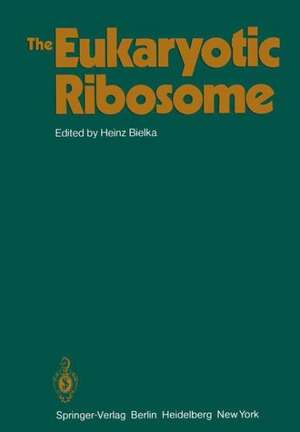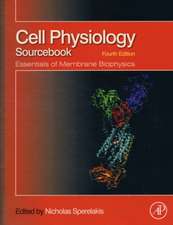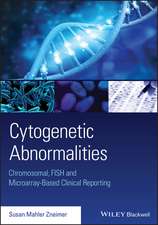The Eukaryotic Ribosome
Editat de H. Bielka Contribuţii de U. A. Bommer, H. Welfle, F. Noll, P. Westermannen Limba Engleză Paperback – 22 noi 2011
Preț: 644.82 lei
Preț vechi: 758.60 lei
-15% Nou
Puncte Express: 967
Preț estimativ în valută:
123.38€ • 129.17$ • 102.09£
123.38€ • 129.17$ • 102.09£
Carte tipărită la comandă
Livrare economică 05-19 aprilie
Preluare comenzi: 021 569.72.76
Specificații
ISBN-13: 9783642682742
ISBN-10: 364268274X
Pagini: 340
Ilustrații: 338 p.
Dimensiuni: 170 x 244 x 18 mm
Greutate: 0.54 kg
Ediția:Softcover reprint of the original 1st ed. 1982
Editura: Springer Berlin, Heidelberg
Colecția Springer
Locul publicării:Berlin, Heidelberg, Germany
ISBN-10: 364268274X
Pagini: 340
Ilustrații: 338 p.
Dimensiuni: 170 x 244 x 18 mm
Greutate: 0.54 kg
Ediția:Softcover reprint of the original 1st ed. 1982
Editura: Springer Berlin, Heidelberg
Colecția Springer
Locul publicării:Berlin, Heidelberg, Germany
Public țintă
ResearchCuprins
I. Introduction.- References.- A short historical survey.- References.- III. Ribosomes within the cell.- 1. Proportion of ribosomes in tissues.- 2. Free and membrane-bound ribosomes.- 3. Ribosomes in nucleoli.- 4. Structure of polysomes in the cell.- 5. Ribosomal crystals.- 6. References.- IV. Some general properties of ribosomes.- 1. Physical characteristics.- 2. Chemical characteristics.- 3. References.- V. Morphology of ribosomes and polysomes.- 1. Electron microscopy.- a) The small ribosomal subunit.- b) The large ribosomal subunit.- c) The monomeric ribosome.- d) Three-dimensional models.- e) Polysomes.- 2. Small-angle X-ray scattering.- a) The monomeric ribosome.- b) Polysomes.- 3. References.- VI. Chemical components.- 1. Ribosomal proteins.- a) Electrophoretic separation and number.- b) Preparation of single ribosomal proteins.- c) Molecular weights.- d) Amino acid composition and amino acid sequences.- e) Stoichiometry.- f) Posttranslational modifications.- g) Comparison of ribosomal proteins of different tissues.- h) Species specificities and evolution.- i) Ribosomal proteins of mitochondria and chloroplasts.- k) Ribosomal mutants with altered proteins.- 2. Phosphorylation of ribosomal proteins.- a) In vitro phosphorylation and de-phosphorylation.- b) In vivo phosphorylation.- c) Phosphorylation of ribosomal protein S 6.- d) Acidic ribosomal phosphoproteins.- 3. Immunochemical properties of ribosomal particles and proteins.- a) Applicability of antibodies.- b) Antigenicity of 80 S ribosomes and their total proteins.- c) Antigenicity of 40 S and 60 S ribosomal subunits.- d) Immunological properties of purified individual proteins.- e) Antibodies to ribosomes in sera of patients with SLE.- 4. Ribosomal ribonucleic acids.- a) High molecular weight ribosomal ribonucleic acids.- Molecular weights.- Base composition.- Sequences.- Secondary structure.- b) Low molecular weight ribosomal ribonucleic acids.- 5 S RNA.- 5.8 S RNA.- 5. Proteolytic and nucleolytic activities of ribosomal particles.- 6. Other components.- 7. References.- VII. Biosynthesis of ribosomal components and biogenesis of ribosomal particles.- 1. Ribosomal RNA.- a) Primary pre-rRNA.- b) 5’ ? 3’polarity of the pre-rRNA molecule.- c) Methylation and pseudouridylation of pre-rRNA.- d) Processing of pre-rRNA.- e) Biosynthesis of 5 S rRNA.- 2. Ribosomal proteins.- 3. Formation of preribosomal particles.- 4. References.- VIII. Dissociation-reassociation processes of ribosomal particles.- 1. Dissociation by withdrawal of magnesium.- 2. Other agents for dissociating eukaryotic ribosomes.- 3. Preparation of ribosomal subunits re-associable to active ribosomes.- 4. Reassociation of ribosomal subunits.- 5. Native ribosomal subunits.- 6. References.- IX. Interaction, topography and function of ribosomal components.- 1. Interactions of proteins and RNA.- 2. Topography of proteins and RNA within the ribosome.- a) Chemical substitution of proteins in ribosomal particles.- b) Enzymatic degradation of proteins and RNA in ribosomal particles.- c) In vitro phosphorylation of proteins in ribosomal particles.- d) Cross-linking of proteins within ribosomal subunits.- e) Localization of ribosomal proteins by immune electron microscopy.- 3. Functions of ribosomal proteins.- a) Functions of ribosomal split proteins.- b) Analysis of functions of ribosomal proteins by chemical substitution.- c) Affinity labeling.- d) Interactions between the small ribosomal subunit and initiation factors.- e) Ribosomal proteins involved in antibiotic resistance and lectin binding.- 4. Functions of ribosomal ribonucleic acids.- 5. References.- X. Interactions of ribosomes with membranes.- 1. Activity of free and membrane-bound polysomes.- 2. Dynamics of ribosomal subunits between free and membrane-bound polysomes.- a) RNA labeling experiments.- b) Reassociation experiments.- 3. Chemical properties of free and mem-brane-bound ribosomes.- a) Ribosomal RNA.- b) Ribosomal proteins.- 4. Components and mechanisms involved in binding of ribosomes to membranes.- a) The role of ribosomal subunits.- b) The role of membrane components.- c) The role of ionic forces and the nascent peptide chain.- d) The role of messenger-RNA.- e) The action of inhibitors of protein synthesis on ribosome-membrane interactions.- 5. Vectorial discharge of polypeptide chains from membrane-bound polysomes.- 6. References.- XI. Function of eukaryotic ribosomes.- 1. Nonribosomal components of the protein synthesizing system.- a) Messenger-RNA.- b) Transfer-RNA.- c) Initiation factors.- d) Elongation factors.- e) Role of GTP during elongation.- f) Termination factors.- g) Dissociation factors.- 2. The process of eukaryotic protein synthesis.- a) Initiation.- b) Elongation.- c) Termination.- 3. Protein synthesis on membrane-bound ribosomes.- 4. Some regulatory aspects of protein biosynthesis in eukaryotes.- a) Hemin control of protein synthesis in reticulocytes.- b) Action of interferon on protein synthesis.- c) Shut-off of protein synthesis after viral infection.- 5. References.- XII. Aphoristic synopsis and outlook.- XIII. Notes added in proof.- XIV. Subject index.- XV. Reference index.








